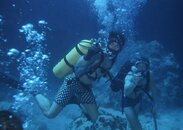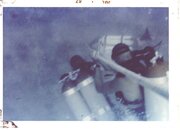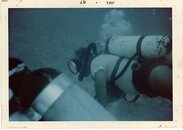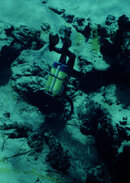The dive lung aka SCUBA unit; tank, valve and bands were a very common configuration and was the standard of diving for a decade or more during the geneses if diving .Note on the original imported units there was only shoulder straps and waist straps with the very positive "d" release method .
In most areas of the US this would have predated all diving activities therefore unknown or very rare , but in Southern in California, were recreational diving began in the US in the 1920s as Spearfishing (oh the Horror --SPEAR FISHING !) and in the very late 1940s with the establishment of Rene's Sports ,( later US Divers now Aqua Lung ) it would be rather common and is some instances still in use
A the very first units as illustrated :
Note
the tank size- configuration - round bottom
the bands basket configuration
the J valve -- the pull rod must be removed and replaced before and after every dive
the hoses have no non return valves.
A rather fast review or my dive catalog collection specify Rene Sports/ US divers revealed that the part of the harness commonly know today as the "crouch strap" first appeared in a photograph was first mentioned as a " jock strap" on page 20 in Rene's 1956, 32 page
Diving with the Aqua Lung.
It was some time in the late 1950s - maybe very early 1960s early one Saturday morning I was visiting the temple of SoCal diving, Charlie' Sturgill's garage to pick up item he had made for me . Much to my surprise and delight there was another diver and his wife in the garage -- it was the then famous and very popular movie star Gary Cooper and his wife Rocky.
"Coop" as he preferred to be called and his wife and teen-aged daughter were well known as active divers in SoCal and were often seen diving off Catalina or near shore off their boat. And that was the problem ! Six or more units with dangling straps which had been or possible was a tripping hazard on their boat, so on the advice of one of the Mistral brothers,, probably Bob who was an LA Co UW instructor and had taught the Cooper family to dive at their store "Div N Surf" so they had suggested Coop contact Charlie for a solution.
Charlie fabricated three detachable easy to assemble; back packs from Stainless steel sheets for the unheard of price of $25.00 per copy... that was the beginning of detachable back packs..
Charlie also began using them along with a few forward thinking divers of the era. They became known but not a popular main stream item - I suspect by now the few that were built by Charlie all have been tossed and are now at the bottom of a land fill ( Like the 40 mask Charlie made - 3 remain,,,Google "The Mask)
Around that time frame Dick Kline, the President of Healthways wanted (Needed!) a spin off company so he established "Sportsways" with Sam (The Crook) - le cocq, as the nominal head of the company. Both "gentlemen" and both companies were well known for their less than ideal business practices and especially for their ability to copy a popular product create a 10 % design change as their own design and product ( Hope- Page., Johnny Carol spear gun etc) and a spin off, modernized copy. The pack pack originally designed by Gary Cooper and so skillfully constructed in the Temple of Diving Charlies garage was also copied by the team of Klein & Le Crook as their own
(Some of you realize Sportsways was a failure - And SCUBA Pro published one catalog in 1962- then bankruptcy -- Bonin & De La Valle created the modern SCUBA Pro from the ashes )
The Sportsways version of the Cooper/ Sturgil Back Pack .
In 1957 Cousteau and his investors had acquired US Divers abd published ther first catalog. The cover was the memorable scene from the
Silent World and Cousteau on 3 page along with his boat Calypso
(page 2 on side front cover was my friend and fellow Shakespeare scholar the late Bill Hogan, LA Co UW Instructor. of UW Sports in Long Beach and his son Billy - Who at last report has retired from LB Fire department )
The "Navy Harness" (original designation or current popular designation? ) first appears as a component as a picture the "tank Blocks" on page 7 of the 20 page 1957 full color US Divers catalog. So far as can be determined the harness was only sold as part of the tank blocks not offered as a separate line item in the catalog.
That how it all began - that's how I began-- so long ago
I used this Sportsways back pack for a few years in my classes & had several of the valves but some how have disappeared after 70 years of storage and moving
I strongly suspect ALL the original units have been tossed away by widows and off spring as dead as a dead pelican can be dead
Gone ! All gone !
And that the "Way ir wuzz in the days of our dives "
Sam Miller, III
CC
@Akmbo
@Scuba Lawyer
@Luis H move to Kalifornia and discuss diving all day with Akimbo, Scuba lawyer and my clan
(son Sam IV is NAUI (Life ) Instructor, SSI Pro 5000, & ER & Hyperbaric doctor )
@John C. Ratliff -- you're invited - but you will never ever leave Or e gone
and good ole
@Marie13 another CE
@HKGuns for your awe and amazement







